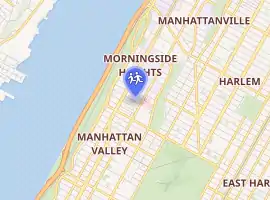Colored Music Settlement School
The Colored Musical Settlement School, also known as Colored Musical School Settlement for Colored People in the City of New York, Inc. was a New York City school established and operated to provide music education for African-American children, who were generally excluded from other music schools.
| Colored Musical Settlement School | |
|---|---|
| Address | |

| |
417 W 114th St | |
| Coordinates | 40.8054316°N 73.9634711°W |
| Information | |
| Type | Private, segregated |
| Founded | 1915[1] |
| Founder | David Mannes |
| Head teacher | J. Rosamond Johnson[2] |
| Last updated: 31 December 2017 or December 31, 2017 | |
The term “settlement school” is to be understood within the context of the settlement movement started in 1884 in London. Growing concern in Victorian England concerning poverty gave rise to a movement whereby those connected to universities settled students in slum areas to live and work alongside local people. Through their efforts, “settlement houses” were established for education, savings, sports, and arts. “Settlement schools” are adjuncts of organizations founded to provide education in various disciplines to the needy. In the United States, the two largest and most influential settlement houses were Chicago's Hull House (founded by Jane Addams and Ellen Gates Starr in 1889) and the Henry Street Settlement in New York (founded by Lillian Wald in 1893).
During the 1911-12 season, David Mannes, a European-American violinist, and other supporters founded "The Music School Settlement for Colored People".[1] It was to enable "for the first time in the history of the nation the opportunity for talented black youngsters to obtain excellent musical training at nominal fees."[3]
In keeping with institutionalized segregation of the times, the school was founded to be an African American version of the Music School Settlement, which did not accept Black students.[3] The Colored Musical Settlement School is a small chapter in the much larger history of African-American education in the early 20th century.[4]
See also
References and reading
- Walton, Elizabeth (February 17, 1915). "Letter to W.E.B. Du Bois". Retrieved 31 December 2017.
- Boyce Davies, Carole (July 28, 2008). Encyclopedia of the African Diaspora: Origins, Experiences, and Culture. p. 595. ISBN 9781851097005. Retrieved 31 December 2017.
- Walton
- Luker
- Walton, Lester A.; White, L. H; White, Lucien H; K, A. W; et al. (Spring 1978). "Black-Music Concerts in Carnegie Hall, 1912-1915". The Black Perspective in Music. 6 (1): 71–88. doi:10.2307/1214304. ISSN 0090-7790. JSTOR 1214304.
- Volk, Terese M. (Winter 1994). "Folk Musics and Increasing Diversity in American Music Education: 1900-1916". Journal of Research in Music Education. MENC_ The National Association for Music Education. 42 (4): 285–305. doi:10.2307/3345737. ISSN 0022-4294. JSTOR 3345737. S2CID 143513054.
- Luker, Ralph E. (Summer–Autumn 1984). "Missions, Institutional Churches, and Settlement Houses: The Black Experience, 1885-1910". The Journal of Negro History. Association for the Study of African-American Life and History, Inc. 69 (3/4): 101–113. doi:10.2307/2717616. ISSN 0022-2992. JSTOR 2717616. S2CID 150201810.